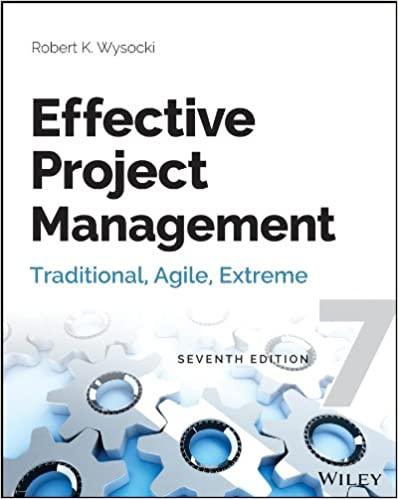Question
Review the video link and develop a risk impact matrix for the project described in the Week 2 Assignment. Identify at least 5 risks for
Review the video link and develop a risk impact matrix for the project described in the Week 2 Assignment. Identify at least 5 risks for this particular project. Prepare a brief summary regarding the matrix, the probabilities determined for each risk identified, and your thoughts regarding how the company should prioritize risk management strategies based on the risks.
Video Link - https://youtu.be/VnVtebvwDdY? si=1ac67CPelHLa18Rx
Week 2 Assignment question - consider the following project scenario addressing how you would perform a qualitative and a quantitative risk analysis to determine where risks may exist within the project. Your company is planning to migrate their file storage and sharing solution from a local server environment to a cloud-based provider. There is approximately 3 TB of file storage with more than 3 million individual files. The files include all of the business financial, HR, and customer data, as well as general operating files for every business department. The company wants to know how long this migration will take and how you intend to ensure the data is protected during the migration.
My Response for week 2 - Assessing Risks in Cloud-Based File Storage Migration
Businesses are switching from on-site servers to cloud-based storage systems due to the rapid growth of technology. In this paper, I will explore the methods of moving around 3 terabytes of data storage, including customer, financial, and HR data, from a server configuration to a cloud service provider. This paper aims to provide a risk analysis technique that combines quantitative methodologies to determine potential project threats.
Qualitative Assessment of Risk - In qualitative risk assessment, threats are identified and ranked according to their impact and likelihood using the experts' subjective assessment (Schwalbe, 2019). Within the purview of this undertaking, the qualitative threats could be roughly classified into the subsequent groups:
1. Data Security-Related Risk : Data theft or security breaches are possible throughout the relocation procedure. For instance, during the relocation, unauthorized individuals can be able to access human resources information, which could lead to serious repercussions including adverse reputational effects and possible legal problems.
2. Threats Related to Technology : Incompatibilities between the network and the freshly installed cloud provider are among these threats. For example, business activities could be disrupted if the cloud-based system fails to integrate efficiently with the company's current software.
3. Risks associated with operations: They involve difficulties in company processes that could arise throughout the switch. For instance, there could be downtime and decreased efficiency if the transfer procedure goes longer than anticipated.
All pertinent parties must be included in the risk assessment procedure to mitigate these threats as well as make sure that all possible dangers are recognized and dealt with. To appropriately address these threats, a strategy for risk management can be established, including risk mitigation techniques such as consistent data backups and stringent security precautions (Hillson & Murray-Webster, 2017).
Quantitative Assessment of Risk - Another type of risk assessment is the quantitative risk assessment, in which a probabilistic evaluation of the company's threats is generated by applying a numerical or quantitative rating. In this project, the two main factors of quantitative threats are :
1. The Time Factor : A project's timeline can be impacted by the length of time it takes to complete the migration procedure. Evaluating comparable information related to the project can help us figure out the time required. For example, we may base our estimate on the fact that prior scale transfers typically took 10 weeks on average.
2. The Cost Factor: The Cost Factor: The possible cost of information loss which could transpire throughout the transfer procedure is another important risk in quantitative research. This risk might be computed by figuring out how much the data is worth to the business. To further quantify the risk, let's say that the loss of a day's worth of firm information is anticipated to cost $300,000 in lost revenue.
It is beneficial to make a strategy with the goal to lessen the risks involved. This could involve migrating an amount of the project's budget for possible data restoration in the event of an outage, or adding time to the project plan to accommodate for setbacks (Kendrick, 2024).
Conclusion - In conclusion, moving to drawbacks but could also offer us perks like file sharing and meeting our storage demands. A comprehensive qualitative and quantitative risk analysis must be performed to properly identify, determine, and reduce risks (Maylor & Turner, 2017). To build a seamless migration process, all stakeholders must be included and work together to establish a robust risk management plan. Please help me find the solution accordingly and include seven scholarly references to cite the solution
Step by Step Solution
There are 3 Steps involved in it
Step: 1

Get Instant Access to Expert-Tailored Solutions
See step-by-step solutions with expert insights and AI powered tools for academic success
Step: 2

Step: 3

Ace Your Homework with AI
Get the answers you need in no time with our AI-driven, step-by-step assistance
Get Started


